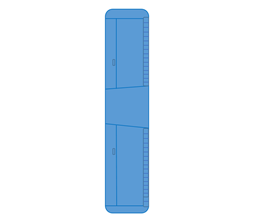Why do wing shapes vary across different types of aircraft?
Why do Wing Shapes Vary Across Different Types of Aircraft?
CHUNG Yan-wa
March 2024
How lift is generated on a wing?

Figure 1 Airflow around an aircraft wing.
The lift of the wing is affected by various factors, including the shape of aircraft wing.
From the perspective of energy conservation, the specially designed shape of the aircraft wing causes the airflow over the top of the wing to be faster than the airflow over the bottom of the wing. According to Bernoulli’s principle, the air pressure on the upper surface of the wing is lower than that from below, resulting in a pressure difference that generates lift. (See Why Windows Shattered by Typhoons Fall Outside the Building?)
We can also start from the perspective of momentum conservation. The shape of the aircraft wing induces a flow-turning effect on the air, thus generating a downward force exerted on the air [1]. According to Newton's third law, this upward reaction force is exerted on the aircraft wing, which is the lift.
From the perspective of energy conservation, the specially designed shape of the aircraft wing causes the airflow over the top of the wing to be faster than the airflow over the bottom of the wing. According to Bernoulli’s principle, the air pressure on the upper surface of the wing is lower than that from below, resulting in a pressure difference that generates lift. (See Why Windows Shattered by Typhoons Fall Outside the Building?)
We can also start from the perspective of momentum conservation. The shape of the aircraft wing induces a flow-turning effect on the air, thus generating a downward force exerted on the air [1]. According to Newton's third law, this upward reaction force is exerted on the aircraft wing, which is the lift.
Tapered versus rectangular wings
When an aircraft generates lift and flies, especially around the wingtips, small vortices are formed (see The “Tail” of an Aircraft). These vortices are actually thieves to steal the aircraft’s drive. Therefore, wing designs with gradually narrowing tapered tips (Figure 2) can reduce the wing’s surface area, resulting in fewer vortices being formed. Overall, the drag due to vortices will be reduced, making the flight more efficient. However, the production costs for tampered wings can be more expensive, which is one of the reasons why training aircraft still use the traditional rectangular wings (Figure 3).
Swept-back wings
The airflow passing over the aircraft wing, due to its specific design, can achieve a speed greater than the aircraft’s own speed. As a result, before the aircraft reaches the speed of sound, the airflow surpasses the speed of sound and generates shock waves. The immense drag caused by these shock waves decelerates the aircraft.

Figure 4 Top view of a swept-back wing.
Swept-back wings deflect part of the airflow over the wings to delay the formation of shock waves. From Figure 4, it can be observed that the airflow (arrow A) impacting the wing is separated into two components. Part of it crosses the wing (arrow B), while the other part flows sideways along the wing span (arrow C). This separation effectively reduces the speed of the airflow crossing the wing, delaying the formation of shock waves. Furthermore, swept-back wings help maintain the aircraft's straight flight.
Let's discuss other considerations in designing aircraft wings later.

